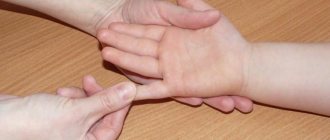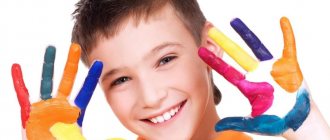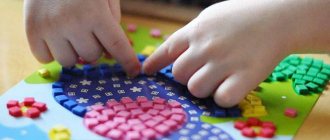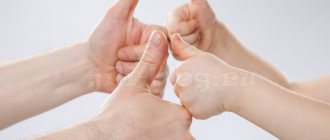Fine motor skills are not fine. Play and develop: improve fine motor skills
You, dear mothers, have probably noticed how your baby awkwardly picks up objects at the beginning of his life, and how interesting it is to watch children when they pick up scissors for the first time. They are so funny, their usual movements turn out awkward.
The content of the article
1. Games for babies up to one year old 1.1.
Finger, finger where have you been 1.2. Chef in diapers 1.3. Future architect 1.4. Mom's assistant 2. Games for children 1 to 3 years old 2.1. Finger games have not been canceled 2.2. Artist and sculptor 2.3. We create what we want 3. Games for children 4-5 years old 3.1. Hello again finger games 3.2. Opening of the season-constructor 3.3. We begin to prepare our hand for writing
I don’t say anything at all about holding a pencil or pen; how many of a mother’s nerve cells die irrevocably when teaching a child to write. All this awkwardness arises due to the child’s undeveloped fine motor skills.
In addition, experts say that fine motor skills of the hands are directly related to the speech center, so I recommend that all parents engage in its development from a very early age.
It is believed that the better the baby can control his fingers, the less problems he will have with speech. Children with developed fine motor skills pronounce all sounds well, begin to express themselves in sentences earlier, their logical thinking is better developed, and their hand is more ready to master writing.
The sooner you start paying attention to this issue, the better the result will be.
In the 90s I had the good fortune to work in a kindergarten. In those not-so-distant times, there were virtually no visual aids or educational games. I had to do everything myself. The children themselves told me what to do. I carefully watched them during the game. In fact, there are a great many games for developing fine motor skills. In this article we will talk about the most popular and, therefore, effective games among children. The result will be positive if the child plays with pleasure!
Methodological development “Development of fine motor skills of hands in children 2–3 years old”
Kovalenko Irina Anatolevna
Methodological development “Development of fine motor skills of hands in children 2–3 years old”
Methodological development . " Development of fine motor skills in children 1-3 years old "
.
All parents know that children need to develop fine motor skills . By developing fine motor skills in children , we stimulate the development of speech . This happens because when performing small movements with the fingers, signals are sent to the cerebral cortex that activate the brain cells responsible for the formation of the child’s speech. That's why you should start developing fine motor skills from a very early age. With this you will influence the active points associated with the cerebral cortex. The importance of developing fine motor skills is very great :
1. Increases the tone of the cerebral cortex.
2. Develops the speech centers of the cerebral cortex.
3. Stimulates the child's speech development .
4. Coordinates the work of the conceptual and motor centers of speech.
5. Helps improve articulatory motor skills .
6. Develops a sense of rhythm and coordination of movements.
7. Prepares the hand for writing.
8. Raises the child's mood.
But not everyone knows how to do this correctly, what activities, games and exercises should be done with children to develop motor skills .
Working with young children to develop fine motor skills , I set the following goals and objectives for myself:
1. Develop fine motor skills of fingers and hands;
2. Develop accuracy and coordination of hand and eye movements, hand flexibility, rhythm;
3. Improve hand movements, developing mental processes: voluntary attention; logical thinking; visual and auditory perception; memory; children's speech .
What are fine motor skills and why is it so important to develop ?
Recently, modern parents often hear about fine motor skills and the need to develop them . What are fine motor skills and why are they so important?
Scientists have proven that from an anatomical point of view, about a third of the total area of the motor projection of the cerebral cortex is occupied by the projection of the hand, located very close to the speech zone.
It is the size of the projection of the hand and its proximity to the motor zone that gives reason to consider the hand as an “organ of speech”
, the same as the articulatory apparatus.
In this regard, it was suggested that subtle movements of the fingers have a significant influence on the formation and development of the child’s speech function. Therefore, in order to teach a baby to speak, it is necessary not only to train his articulatory apparatus, but also to develop finger movements, or fine motor skills . Fine motor skills of the hands interact with such higher properties of consciousness as attention, thinking, perception (coordination, imagination, observation, visual and motor memory, speech. The development of fine motor skills is also important because the child’s entire future life will require the use of precise, coordinated movements hands and fingers, which are necessary for dressing, drawing and writing, as well as performing many different household and educational activities.Teachers
and psychologists recommend starting active training of a child’s fingers from the age of eight months.
Development of fine motor skills.
start working on developing fine motor skills from a very early age. Already in infancy, you can massage your fingers, thereby influencing active points associated with the cerebral cortex. In early and early preschool age, you need to do simple exercises accompanied by a poetic text (for example, “Magpie”
).
The development of fine motor skills is one of the most important areas of development for children aged 1-3 years . And not by chance! By developing children's fingers , we not only help the child learn to master his hands, but also:
- stimulate the development of speech in the child (the areas of the brain responsible for small movements of the fingers are closely related to the areas of the brain responsible for human speech; it has long been proven that activities the development of fine motor skills of the hands also stimulates the development of speech in children );
— we help develop the child’s intelligence as a whole;
— we prepare the child’s hand for mastering such important skills as writing, drawing, using scissors, dressing and performing other actions for which dexterous fingers are important.
Development of fine motor skills in children from one to two years old
You will notice how by this age the baby has “improved”
the ability to move his hands; he learned:
- grab small objects (bread crumbs, beads, corn flakes)
.
- hold all the same objects with the index finger and thumb, in a bent state, which indicates the development of a “pinch grip”
.
Using your child's similar skills, you can further develop his fine motor skills and hand-eye coordination, as well as his eye, for example, through games with small objects.
Development of fine motor skills in children 2-3 years old
In a child of the third year of life, fine motor skills also develop at a rapid pace, only they are already associated with the formation of cognitive skills. The child takes certain actions to obtain new information: he throws, touches, breaks toys and thereby studies them. When a child sculpts, cuts, draws, fastens buttons under the guidance of an adult, he also learns and gains new knowledge.
What to do if you discover poor development of fine motor skills in your child?
You need to be patient and begin to gradually correct this deficiency systematically, every day. You can use your child’s regular activities for this. Watch how the child washes and dries his hands. Teach him to wash each finger thoroughly. And then dry it just as thoroughly with a towel, massaging each phalanx well. If you have a garden, take advantage of it and involve your child in picking berries.
There are also special games and exercises for developing fine motor skills of the hand . Some of them have been known to you for a long time. For example, playing in the shadows. This is when using various combinations of fingers they show various shadow figures - a bunny, a dog, a little man. Another common game is identifying an object covered with a napkin by touch. Think about the games of lacing.
Most modern children have a general motor lag , especially urban children . Velcro shoes are now common and children often do not have to tie their laces. More than anything else, a small child wants to move; for him, movement is a way of understanding the world. Accordingly, the clearer and more precise the children’s movements are, the deeper and more meaningful the child’s acquaintance with the world will be.
Games and exercises for the development of fine motor skills in children 1-2 years old .
Folding into a bottle. Encourage your child to throw small objects (beans, raisins, popcorn, candy)
in a bottle with a narrow neck.
It is better if the bottle is made of transparent plastic, so the baby will be able to observe the process of getting the object inside. Comment on each of your actions: “One bead is already inside.
Now the second one..." , and be sure to praise the baby for his achievements.
Then, when the beads fall into the bottle, show your child how using special movements (grabbing an object with your index finger and thumb)
you can
“rescue”
them back. This kind of game is aimed specifically at coordinated finger work.
Important! When your baby plays with small objects (especially if they are inedible), do not leave him unattended, even for a short time.
Games with cereals. Use both large grains (beans, beans) and small grains (buckwheat, rice)
.
Invite your child to pour the cereal from a flat plate (tray)
into a transparent deep bowl.
The main condition is that the baby will have to take the cereal directly with a pinch. When the cereal is in the bowl, it will be necessary to pour it back. The game is aimed at developing coordination and accuracy of hand movements.
Mosaic. Give preference to those mosaics that have large chips of different colors (it is better if there are no more than four of them, a small playing field with a small number of holes.
What games can you play:
• sorting chips by color;
• laying out the “track”
from elements of the same color;
• laying out basic geometric shapes (circle, square, triangle)
;
• laying out the pattern according to the proposed sample.
Games with bottles and jars. The child is offered bottles and jars with necks of different diameters (perfume bottles, bottles of sparkling water, medicines, jars of cosmetics); Unscrew their caps in advance and place them mixed in front of the baby. The child’s task is to select the appropriate cap for each jar and bottle and then screw them on. The purpose of the game is to develop the muscle strength of the leading hand.
Putting objects on a rod . The baby can put on the rod either rings or pyramid figures adapted for this purpose, or, for example, ordinary dryers.
Hammering the pegs. The child learns to hammer in pegs using a toy hammer, without making unnecessary movements and without swinging too hard. Such games help strengthen muscle strength, develop coordination and accuracy of hand movements.
Games with clothespins. Such games are useful for children who need to increase muscle strength in their fingers. For the first lessons, it is better to choose plastic clothespins that do not need to be pressed hard to open them.
Let the child take a clothespin, open it and attach it to a piece of thick cardboard. When the baby masters such manipulations, you can offer him other activities, for example, attaching clothespins:
• on a rope (pre-stretch it between the chairs)
;
• for cardboard stencils (basket, herringbone)
.
•for example: the game “Needles for the Hedgehog”
,
“Rays for the Sun”
These games are very loved by mothers and teachers, because clothespins are inexpensive, children love to tinker with them, and there are a huge variety of games with clothespins! Using clothespins we make needles on the back of the hedgehog, rays for the sun, etc. This is a good exercise for developing fine motor skills , which is also a tactile exercise. The task is to attach ordinary clothespins to the edges of the circle with three fingers.
Games with foil. Put it in a “box”
from under the kinder surprise, a few beads, balls or a toy, and wrap it in a sheet of foil.
Get your child interested by rustling
a ball of foil and shaking it.
The baby will want to unwrap the “packaging”
and find out what is inside.
By unfolding the foil , the child will be focused on the process and use his dexterous fingers.
Removing items from a bag . For such games, use a transparent plastic cosmetic bag or a small purse with a zipper. Put small surprises and interesting things in your purse: a bell, a perfume bottle, a small toy, an old remote control, candy, unnecessary papers. The child will have to work hard to get to the contents.
Opening toys. Games with nesting dolls and eggs
from kinder surprise, small boxes and plastic containers. It’s better to put something inside (let it be some kind of treat: candy, dried fruits, nuts, corn sticks).
Puzzles, cut pictures . For babies of the second year of life, puzzles and pictures consisting of several parts (no more than four)
;
let them have a different cut , for example, wavy, horizontal, vertical. First, assemble the picture yourself and show it to the baby, then take it apart and help the child put it back together. Such an activity will have a beneficial effect on the development of thinking , fine motor skills and spatial awareness.
Games with toys - inserts, pyramids. Pyramids - contribute to the development of fine motor skills of the hands , independence, attention, color perception, holistic perception of an object, logical and associative thinking of the child. The child learns to select figures according to shape and insert them into the corresponding holes. Thanks to such activities, children develop fine motor skills of their fingers , and also become familiar with various geometric shapes and different colors.
Games and exercises for the development of fine motor skills in children 2-3 years old .
Stringing. Demonstrate to your child the process of stringing beads (they should be large enough, at least 12 mm in diameter)
onto a cord or wire
(it is better to treat the ends of the cord with paraffin or glue)
. You can also ask your child to string small dryers and wooden rings onto a string.
Game: “Make Beads”
.
develop fine motor skills with pasta.
I like this method because while the mother is minding her own business, the child can spend time usefully. Making these beads from pasta with your own hands is not at all difficult. You will need pasta with a large gap and a string. Task for the child: string the pasta onto a string. You can take pasta of different colors or different shapes. Lacing. Games with lacing prepare the baby for mastering more complex skills - modeling, drawing. The child learns in this way to concentrate visual attention, coordinate his movements, and master subtle finger movements. Types of lacing: toys made of wood or textiles (buttons, fruits, soft toys)
with a thick cord that must be threaded through the holes; rigid cut-out toys with through holes and laces.
Unfastening buttons and buttons. To develop such a motor skill , it is better to choose special toys with buttons, snaps and hinged loops (this will be more difficult to do on clothing items)
. The baby must learn to unbutton and fasten buttons of different diameters.
Construction of the tower. Invite your child to build a tower from non-standard parts (lotto barrels or dominoes, bottle and bottle caps, plastic cups).
Games with household items. Household items and things from the “adult world” developing fine motor skills.
. Show how to turn the handle and open the door, press the bell or elevator button, dial a number on the phone, etc. Such activities will strengthen the muscular strength of the hands and develop coordination of movements.
Basics of origami. Show your child the simplest actions with paper (for example, folding a sheet in half)
. Grasp the baby's hands and demonstrate to him the entire sequence of actions.
Modeling. This type of activity promotes the development of hand motor skills and stimulation of the tactile sensitivity of children's fingers. First, you will have to show your child the process of transforming a shapeless lump into figures and interest him. It is important for the child to grasp a clear connection between hand movements and the result (the shape that can be obtained.
At first, he will learn to create simple, primitive figures: balls, sausages, flat cakes, but this will contribute to the desire to create something specific. It is important to prepare the material for work (since kids may have difficulty with this)
: knead the plasticine until it becomes soft and elastic.
Start with simple exercises, for example, rolling out a small piece of plasticine with straight movements between your palms. Imagine with your child, let it not be ordinary sausages, but, for example, posts for a toy fence or sleepers; and when you connect the ends, you get a ring or a donut. Afterwards, you can begin to master the process of sculpting round-shaped objects .
Drawing on semolina. For games you will need a tray on which semolina is poured.
You can draw the sun, a cloud and rain, a flower, etc. with your mother.
I would like to note semolina drawing for children - this technique is an innovation that fascinates every child. With its help creative thinking , fantasy, imagination, fine motor skills and much more .
Search for treasure. This is very useful, since during such “excavations” the child makes movements with his fingers similar to those he makes when performing finger gymnastics.
Playing with cereals is not only an excellent educational activity for children . They also have a calming effect. For such games, any cereal available in the house is suitable - beans, peas, buckwheat, millet, rice, etc., you can use semolina. small toys on hand . At the very bottom you need to find the treasure.
Drawing with cotton swabs. (Maybe teamwork)
.
If you are the mother of a 2-year-old child, then of course you know that teaching your child to correctly pick up a pencil or brush is not at all easy.
It is very difficult for a child to hold a pencil correctly in his hand. And they resist in every possible way when you want to teach them to hold the brush correctly.
But there is a way out - drawing with cotton swabs.
It will be more convenient for small fingers to hold a light stick, and the drawing will come out naturally. A two-year-old child will definitely be interested in such an exciting and simple technique. In addition, drawing with a cotton swab develops fine motor skills . The technique of drawing with cotton swabs is reminiscent of a mosaic, when a picture is born from magic grains, step by step. At first, the child needs the help of an adult, because without an accompanying game, drawing with cotton swabs is not very interesting for children . The principle of this technique is simple: the child paints over the picture with dots. To do this, you need to dip a cotton swab in the paint and apply dots to the drawing, the outline of which has already been drawn.
Conclusion:
tasks and exercises aimed at developing fine motor skills . If you wish, especially if you use your imagination and imagination, you can come up with them endlessly. And the main thing here is to take into account the individual characteristics of each child, his age, mood, desire and capabilities. Fingers will not become skillful right away. Games and exercises, finger exercises, carried out systematically from a very early age, help children confidently hold a pencil and pen, braid their hair and lace their shoes independently, build from small parts of a construction set, sculpt from dough and plasticine.
Thus, if the fingers develop , the child’s speech and thinking will develop .
Games for babies up to one year old
It is necessary to develop fine motor skills from the age of 6 months. To do this, children need to be given objects of different textures in their hands so that they can explore the world by touch. All toy parts must be large enough. You can simply knead your favorite soft toy, you can squeeze/unclench your palms, etc.
Finger, finger, where have you been?
As for games, personally, from my experience, I would advise you to start with finger games.
The main goal of finger games is to switch attention, improve coordination and fine motor skills, which directly affects the mental development of the child. In addition, they help establish an emotional connection between the baby and mother. He hears her voice, tactile contact occurs (touch is very important for a child. Hug and stroke your baby more often). Plus the emotional coloring of the game (kids are very sensitive to their mother’s mood, so there are more positive emotions, my dears). The top finger games for kids are “Ladushki, Ladushki” and “Magpie White-sided”.
Why they? It seems to me that each of us already has them at the genetic level. Therefore, they are easily perceived and assimilated by the child. Children under one year old play this game with great pleasure. And literally, after a few days, they themselves begin to repeat the movements after you. It seems to me that they are especially drawn to this - “They flew, they flew, they sat on their heads,” my kids just laughed.
As the child grows up, the range of finger games can be expanded, keeping them in your piggy bank until school age, for example:
This finger is small, (bend the little finger) This finger is weak, (bend the ring finger) This finger is long, (bend the middle finger) This finger is strong, (bend the index finger) This finger is fat, (bend the big finger) Well ?a?together - fist! Since 9 months we have been actively adding games with objects
Chef in diapers
No matter how unpedagogical it may sound, for some reason the most popular item for children to play with is kitchen utensils. My eldest son could sit with me in the kitchen for hours, transferring spoons from pan to pan, or stacking bowls (well, it’s generally convenient - mom cooks and the child is busy with her). I think an interesting option could be plastic containers of different sizes - you can open the inserts and lids, and if your mother is kind, you can pour some water. Well, in general, your imagination has plenty of room to run wild.
Future architect
In second place in popularity among games for the development of fine motor skills (according to my observations) are pyramids.
Children really like large pyramids that are their height, well, not big ones, but voluminous ones are also suitable (naturally, the demo version is for you at first, mom). By the way, multi-colored pyramids are an excellent tool for learning colors with a child. Someone will object, they say, it’s too early. I will answer - try to collect, but don’t force it. The pace of development of children is different for everyone. The third place is confidently occupied by cubes - soft, large and ordinary large plastic ones of different colors are suitable.
Then there are the liners. There are a great variety of such games in stores now. For now, choose something larger and simpler in shape, oval, square, etc. so that the baby would be interested.
Mom's assistant
A useful activity for a child who does not yet know how to stand confidently on his feet, but is actively crawling, would be collecting various objects on the floor.
Scatter blocks or play balls throughout the room, place a basket and encourage your child to bring objects into it. In addition, up to the age of one year, the child is allowed to play and be naughty at the same time. For example, find a piece of paper and ask your child to tear it, after demonstrating how to do it. You can also ask your child to remove it by analogy with cubes and balls. There is one important condition. You must play with the baby. Play until he himself masters the movements that are so difficult for him. You don't have to have 151 thousand games in your arsenal (you won't remember anyway). While playing, you will understand what your child likes. He will choose the games that suit him best and enjoy his health!
Games for children 1 to 3 years old
The period from 1 year to 3 years is the most greedily cognizable.
The child quickly masters the world and tries literally everything. Play and play again is the only form for communication and development of children in preschool age. Your adult nerdiness: “do this, behave correctly, etc.” will lead to nothing. Everything through the game!!! The only obstacle to this can be your laziness. Don't be lazy, play, and you will see the wonders of your gaming education.
Finger games have not been canceled
Our hit parade is still headed by finger games. These are universal games that can be played throughout the preschool or even primary school period of a child’s life (they just become a little more complicated).
| One, two, three, four, five - We went out to the kindergarten for a walk. We walk, we walk through the meadow, There flowers grow in a circle. There are exactly five petals, you can take them and count them | Using the finger of one hand, we count the fingers on the other, lightly pressing on the pads. With the index finger of one hand we perform circular strokes on the palm of the other. We count our fingers, stroking them in reverse order. |
Then we read the poem again and repeat all the movements on the other hand.
| Once you've played, relax, shake your fingers. Bend your fingers, just like bunny ears. | Relax your hands and shake them. We place both palms with fingers pressed against each other to the head and bend the closed fingers several times. |
The poem and all movements can be repeated.
Artist and sculptor
Drawing is in second place (this again, in my opinion and experience, yours may be different. Write, then we’ll discuss).
First try with your palms and fingers. Old wallpaper (there is room to roam) and paints for hand painting are perfect. This is where the fun and freedom are (the main thing is not to decorate the carpet).
Then we learn to hold a brush and pencil with crayons and draw, draw, draw!!! Moreover, at the beginning of your artist’s career, it doesn’t matter what, the main thing is that your fingers and brushes work. Your task is to inspire the master.
Modeling is definitely a favorite activity of almost all children.
Materials can be varied: plasticine, special clay,
Dough (yes, yes). Knead your child's regular unleavened dough and let him sculpt.
Make your own dumplings, sit your child next to him and let him sculpt masterpieces, it doesn’t matter that the whole kitchen and the creator are in flour, it’s all fixable, but what a pleasure it is.
We create what we want
Next on the list of popular games are all sorts of inserts and large mosaics. You can collect large buttons at home by making a slot in the lid of a plastic container that can be easily opened according to the size of the buttons. The child puts the buttons in a “piggy bank”, then pours them out, and then puts them back again. My students were simply shaking for this “piggy bank.” Attention! Take large buttons, because for some reason the temptation for children to put a button in their nose or ear is very great.
You can simply mix beans and rice and ask them to put them separately in different containers, or you can even entice your baby with role-playing games. For example, take different figures of domestic animals, make plates for them from plasticine and feed them each with cereal.
And also locks, latches, at home you can equip a mini-stand with a switch, loops with a lock, etc.
And of course, where without clothespins
This handy material is loved not only by the children themselves, but also by parents and teachers.
Firstly, everyone has clothespins at home, secondly, they cost pennies, and thirdly, they can captivate a child for a long time and with benefit.
Using clothespins you can practice construction skills and learn colors. To do this, you need to make blanks from cardboard, for example, cut out a yellow circle, which will later become a sun with rays-clothespins, or the body of a hedgehog, which will have pins-pins attached, etc.
In addition, you can cut out 4 geometric shapes of different colors from cardboard, and ask the child to put clothespins of the same color on each of them.
Cinderella
Remember the task that the evil stepmother gave instead of a ball? Poor Cinderella had to sort the cereal. You can offer your child to sort out the mixture of peas and beans - just take a little, even the unrequited heroine of the fairy tale did not have the patience for this. Use different nuts or construction parts, maybe geometric ones. At the same time, learn shapes and colors, names.
Games for children 4-5 years old
Hello again finger games
"Centipedes"
| Along a winding path | The hands rest on the table with their pads (centipede feet). On command, the “centipedes” begin to move quickly. All fingers are involved in the movement. “Centipedes” can change the direction of movement on the command “right”/”left”, running around small objects on the table. |
| Centipedes are running into the garden. | |
| One two three four five - | |
| No one can catch them. |
"Butterfly"
| In the morning the sun will shine - | The thumbs of both hands cross, and the palms are placed horizontally and turn into the “wings” of a butterfly. |
| A butterfly takes off from a flower. | |
| If he flutters around, he gets tired, | The “butterfly” sits on the back of a chair (the edge of a table, a book, etc.), folds its “wings,” and then begins to fly again. |
| When he rests, he spins again. |
Let's continue to create
This period is ideal for children to independently complete creative tasks under the guidance of an adult.
- modeling
- appliques (learning to work with scissors)
- drawing
- Opening of the season-constructor
Recently, while cleaning my son's room, I came across a huge box of construction kit parts.
You know, from this age until almost 14 years old, this was my child’s favorite activity. He sat for hours and created masterpieces from these details. So, if your baby asks for a construction set, don’t be greedy, buy it, it’s a very good activity for developing fine motor skills. The construction of entire cities and railways, which can be used for further play, is an ideal educational pastime.
We begin to prepare our hand for writing
Those who like to draw can be given the task of tracing pictures along dotted lines or writing various small icons, for example, cells, circles, etc. In this way, the hand is prepared for writing, which will have a beneficial effect on your child’s handwriting in the future.
All the games we described develop not only fine motor skills of the hands, but also tactile sensations, help to learn basic colors, shapes, and navigate in size. Remember, the more you play with your child, the more interesting it will be for him to explore this world.
Stick winder
Take any stick and tie a strong thread, braid or ribbon to it. It should be long enough. You can attach a small toy to the other end. The child winds the thread on a stick, and the toy slowly approaches him. The game helps develop the skill of coordinating movements of both hands. In the future, you can use a regular ball.









